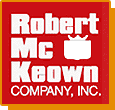Author: sachin
Conductive Tapes – A Selection Guide
Conductive tapes are flexible adhesives that conduct current on one or both sides. These tapes are a useful and cost-effective option for electronic assembly, especially in shielding or grounding applications.
Conductive tape offers many advantages over other assembly methods such as soldering or mechanical fastening. Tapes are flexible, easy to apply, and offer better performance in settings with extreme temperatures or frequent vibrations.
At Robert McKeown Company, we offer a full range of conductive tapes for clients seeking these benefits for their electronic assemblies. As a long-time supplier of high-performance electronics materials, we can work with you to determine the best adhesive tape solution for your needs.
CONDUCTIVE TAPE TYPES
Conductive tapes can be classified in several ways:
- Conductive Adhesive vs. Non-Conductive Adhesive. Tapes with conductive adhesive conduct electricity on both the top and the bottom. The polymers that make these tapes sticky contain tiny, embedded metal particles that conduct current. By contrast, some conductive tapes do not have these embedded components, so they only conduct current on the non-adhesive surface.
- Isotropic vs. Anisotropic. Isotropic tapes conduct current in every direction while anisotropic adhesives conduct along only one axis.
- Material. Conductive tapes can be made from many different materials, including copper, aluminum, and conductive alloys.
Robert McKeown Company offers performance CHO-FOIL tapes in several material options with conductive and non-conductive adhesives:
- Copper Foil Tape. Copper is highly desirable for electrical applications because of its excellent conductivity, which is second only to silver. Copper is a particularly good choice for both grounding and shielding applications because it reliably blocks both magnetic and electrical waves for maximum performance.
- Aluminum Foil Tape. Although its conductivity is slightly lower than copper’s, aluminum tapes offer excellent electrical performance and shielding characteristics. Aluminum tape also tends to be more cost-effective than copper or tinned copper tapes.
- Tinned Copper Foil Tape. Tinned copper foil has similar electrical properties to copper foil, but the tin content makes the tape more resistant to humidity and extreme temperatures. Unlike unalloyed copper, tinned copper won’t oxidize in these more difficult environments, so it is a better choice if durability is a concern.
Before purchasing conductive tape, it’s important to understand these distinctions to ensure you get the results you’re expecting.
COMMON APPLICATIONS FOR CONDUCTIVE ADHESIVES
Conductive tapes have many uses, but the most common involve shielding and grounding. For instance, they are often used to attach EMI and RFI shields to electronic devices. They can also be used to pass current to substrates that cannot be soldered or to create corrosion-resistant ground contacts, among other applications.

